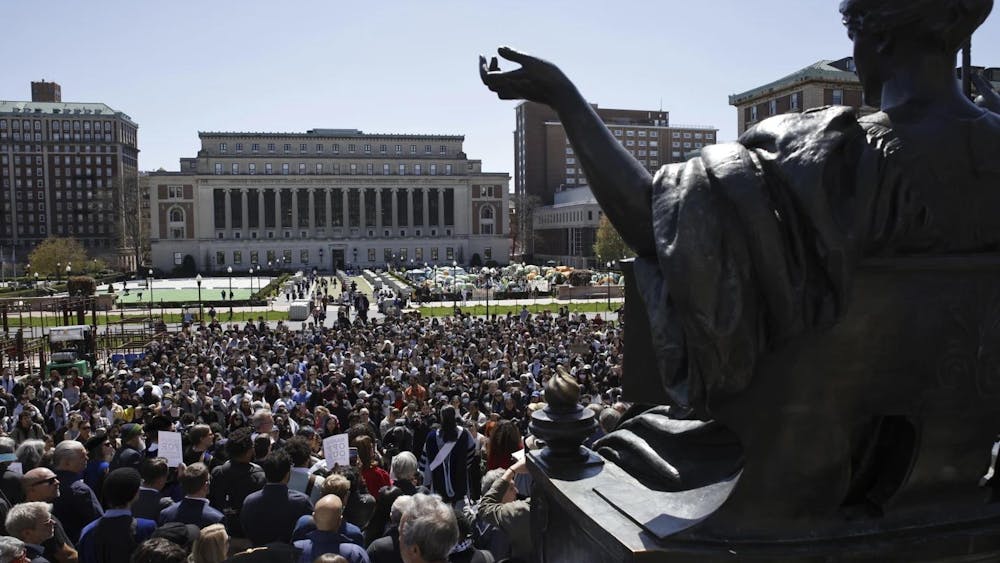The Special Friends Club of Notre Dame and Saint Mary’s — a student group that pairs students with children in the South Bend community who are affected by autism spectrum disorders in the hopes of building friendships — hosted the sixth annual Notre Dame Autism Conference on Tuesday.
Junior Allison Baglini, president of the Special Friends Club, said the group chose the keynote speaker for their first conference after a two-year hiatus to focus the conference on applied behavior analysis (ABA).
“Another goal of our club is to increase education and awareness of autism and autism research, and this year’s conference is about applied behavior analysis,” she said. “ … It’s a great opportunity to reflect on the fact that there are many different approaches to intervention in the lives of individuals with autism, and that’s what I hope people take from it — just to think a little bit more about different approaches towards intervention.”
The club chose ABA as the topic for the conference to explore due to its relevance, as well as interest from parents of children involved with the club who may be searching for effective methods of intervention, Baglini said.
The conference consisted of a lecture aimed at students, faculty and staff entitled “Working Towards a Progressive Model of ABA,” and a family workshop entitled “Making Meaningful Differences Through ABA.”
Keynote speaker Justin Leaf, director of research at the Autism Partnership Foundation, said the Autism Partnership Foundation provides intervention assistance to people affected by autism. This disorder affects one in every 68 children, a number that has objectively risen, Leaf said.
Though there are hundreds of approaches to improving the lives of those with autism, Leaf said he, along with The Autism Foundation, endorses ABA, an approach developed by psychologist Edward Thorndike in the 19th century and based on behaviorism.
In other words, Leaf said, ABA is “simply good teaching,” which involves providing motivation, clear feedback and assistance when necessary, but building independence at the same time.
Leaf said he has seen positive results from the ABA method in his own clinic. When using the ABA method, he said, 70 percent of the children who received intensive ABA intervention are now considered to meet the best outcome according to clinical data.
“We know that when individuals receive quality intervention they can make really good improvements, life altering changes for the better,” he said.
However, Leaf said, ABA has gained a negative reputation among those who have seen it implemented in incorrect forms, including an overly rigid curriculum, the use of food as reinforcement and other characteristics that Leaf deemed “bad ABA.”
Components of the progressive model Leaf has seen success with include a more structured, yet flexible approach that allows parents and teachers to make in-the-moment decisions regarding reactions to their child’s behavior, he said. This quality ABA is conducted intensively in a natural setting that teaches a child to handle distractions, with a curriculum that does not necessarily have to adhere to rigid protocols.
Leaf voiced some concerns about inadequate training of instructors of people with autism, and said staff members should be fun, engaging, receptive to feedback and professional. The majority of instructors are certified using the Routines-Based Interview (RBI) technique, which Leaf said he believes involves a smaller amount of training than should be required.
“There’s no research that shows 40 hours is enough,” he said. “For me it takes years and years of training to be proficient at it … the certificate means you are only minimally qualified.”
To combat this issue, Leaf said he promoted time training academies, such as the Center for Applied Behavioral Analysis (CABA), which provides intensive quality ABA training to individuals.
“We need people who are investing in training and realize investing in our professionals is the way to go,” he said. “Our approach is based on clinical judgment. Our approach is not rigid protocols, our approach is to have flexibility to adapt and change based on the needs of the child and the environment which they’re in.”
Leaf warned against falling for the resurgence of “social thinking” — a procedure based on the idea that change in thought will force a change in behavior — and other intervention techniques that have little to no scientific research to back up their claims of success. Warning signs of such procedures include the reliance on anecdotal evidence to prove success, Leaf said.
“I want you to behave differently if you’re in the field,” he said. “I want you to do that progressive model, I want you implement letting teachers make clinical judgments and make their own decisions, as opposed to following rigid protocols. And that’s my hope for the field.”
In his second talk aimed at parents of children on the autism spectrum, Leaf once again discussed the same ABA techniques, and provided additional information that would assist a parent in using the methods in their home. In addition to implementing clinical judgment, curriculum that teaches applicable skills and quality staff, Leaf urged parents to keep high hopes for their children affected by disorders on the autism spectrum.
“We are in this field to make meaningful differences, and parents, you should have high hopes and professionals, you should have high hopes,” he said. “We have to be like the little engine that could, we have to be like my idol from Notre Dame, Rudy … or Rocky or Helen Keller. It’s having high hopes. These are the components of quality ABA to me, and when we implement these components we get good quality outcomes.”













